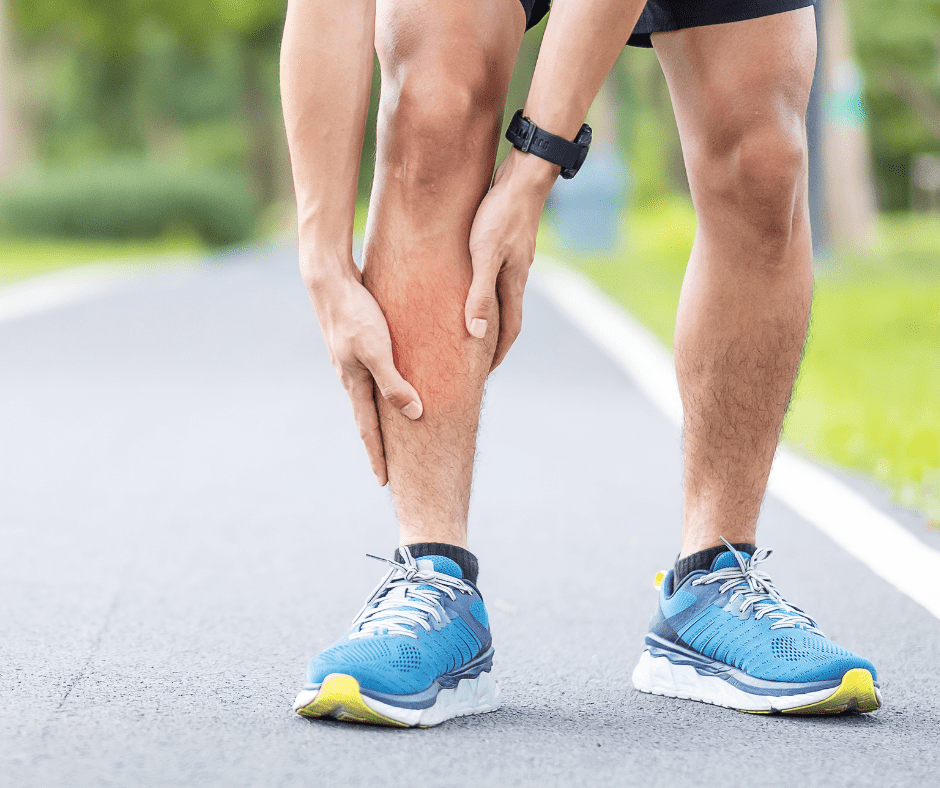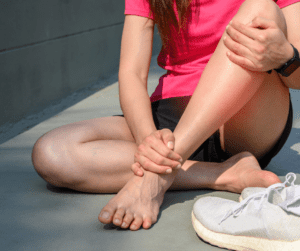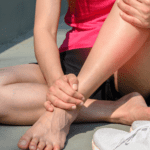One of the most common running injuries we get asked about is shin splints and how to get rid of them…
A common misconception about shin splints is that they are an actual condition of the shin bone or tibia.
Shin splints describe the pain felt along the front of your lower leg, at the shin bone. The pain concentrates in your lower leg between your knee and ankle.
The pain can be caused by inflammation of the muscles, tendons, and bone tissue.
Let’s have a look at what shin splints are in a bit more detail, but more importantly, what is the best way to avoid getting them?

Shin Splints
As we already mentioned, a common misconception about shin splints is that they are an actual condition of the shin bone or tibia.
That is not true.
Shin splints are normally caused by one of the muscles that are running down the tibia. Typically it is the medial or inside of the shin that normally hurts.
The connective tissues between the muscle and the shin become inflamed and it starts to pull away from the shin, causing shin pain.
That is really the pain that you are feeling.
(Side note: extreme levels of pressure and tightness may actually indicate compartment syndrome)
There is, therefore, pressure running through the tibia…
If we don’t treat it and you keep running through the pain, shin splints will ultimately turn into a pre-stress fracture (which is a little bit of bony oedema and bleeding on the actual bone).
Ultimately, if you continue running shin splints, it could turn into a stress fracture of the tibia.
Shin splints are an extremely common novice runner’s injury.

This is because as human beings we are always driven to succeed, improve, go faster, get better and run longer.
Often this is what happens as we always build up too quickly, and we then typically get shin splints.
There are a few other main causes of shin splints…
What Are Shin Splints Caused By?
The most common causes of shin splints:
- Doing too much too soon.
- Running in the incorrect running shoes.
- Not having a body that is adapted for exercise.
- Stress reactions to bone fractures.

How To Tell If You Are At Risk Of Getting Shin Splints?
There are a few risk factors to consider that give you a higher chance of getting shin splints…
- Not having a body that is adapted for exercise, such as flat foot syndrome.
- muscle weakness in your thighs or buttocks
- Lack of mobility
- Running on a slanted surface or uneven terrain
- Running on hard surfaces
- Using worn-out shoes
How To Tell If You Have Shin Splints
Shin splints can be recognized by a dull, aching pain along the front or inside of your lower leg.
This discomfort often arises during or after activities like running and jumping.
Pressing on the inner edge of your shinbone might reveal tenderness, confirming that you have shin splints.
If the pain eases with rest but returns during physical activity, and if you notice mild swelling in the area, shin splints could be the culprit.
Let’s chat a bit about the recovery process…
How Long Do Shin Splints Take To Heal?
There’s no way to say exactly when you will be fully recovered from your shin splints…
It really depends on what caused them. People also heal at different rates.
When you feel that you are recovered, you should make sure to properly warm up, and you should do so gradually over a few weeks.
Static stretching doesn’t help you warm up in the way that people used to think it does. It’s Dynamic stretching that will help you run efficiently.
Try to start out running on soft, level ground, and wear the correct shoes.
Don’t Ignore The Pain From Shin Splints
A major issue with shin splints is people tend to ignore the pain.
Pain is a signal from your body telling you something isn’t right…
Runners think it will get better as they get a little bit fitter but that is generally not the case. This is why people often end up with quite a serious case of shin splints.
How To Relieve Shin Splint Pain
To relieve shin splint pain, start by resting and avoiding high-impact activities. Applying ice several times a day helps reduce pain and swelling.
Gentle stretches for your calf and shin muscles can improve flexibility. Strengthening these muscles through exercises provides better support. Engaging in low-impact exercises like swimming or cycling maintains fitness without stressing your shins. Proper footwear and using arch supports can alleviate strain.
Over-the-counter pain relievers might help but consult a doctor first. Gradually reintroduce activities and consult a professional if pain persists.
The good news is, that even if it is serious, it shouldn’t take more than two weeks to deal with the actual pain.
How To Get Rid Of Shin Splints
To heal shin splints from the acute phase can take anywhere in the region of 48 hours to two weeks, depending on how far you pushed yourself into the pain.
- The first thing you need to do is rest.
I know, it’s the last thing a runner wants to hear…
…but continuing to run is just going to make the shin splints worse.
You can also take an anti-inflammatory if needed to help speed up recovery, but this is not a long-term solution and should be recommended by a doctor.

- The second thing you need to do is run an ice pack over the affected shins for 20 minutes three times a day.
This will also help settle the inflammation.
- Thirdly, a very simple strength training program will help strengthen your lower and upper legs, as well as your glutes and core.
Exercises like toe raise and forward & lateral band walks, for example, are perfect. Our free strength training plan is a great place to start and you can download it by clicking here.
- And then lastly, grab a foam roller and foam roll your legs.
In summary…
What You Can Do Right Now To Heal Shin Splints Fast:
- Rest (Take an anti-inflammatory, if needed, to settle the inflammation)
- Run an ice pack over the affected area 3 times a day for 20 minutes
- Strength training twice a week
- Foam rolling daily
Common Mistakes Runners Make While Treating Shin Splints
- Skipping Rest: Avoiding rest hampers healing and can worsen shin splints.
- Abrupt Return to Running: Hasty return to running can retrigger pain; gradual re-entry is key.
- Ignoring Proper Footwear: Ill-fitting shoes strain shins; invest in good shoes.
- Neglecting Stretching and Strengthening: Skipping exercises harms flexibility and balance.
- Lacking Professional Guidance: Self-treatment delays recovery; consult experts for tailored advice.
So avoiding shin splints altogether would be the best-case scenario, but how do you not get shin splints?
How To Prevent Shin Splints In The First Place
- Get Proper Running Shoes
When people start running they very seldom start off in the right pair of running shoes.
They decide they want to start running to get fit and improve the quality of their life or to run a marathon.
Whatever the reason is, they go into their closet and pull out whatever shoes they’ve got in there.
Their excitement and exuberance to get started, plus very often incorrect footwear is a lethal combination when it comes to shin splints.
If you want to discover which shoes you need, have a look at this: The Ultimate Running Shoe Comparison: Trail Vs Road
- Strength & Conditioning Training To Get Rid of Shin Splints
Here are some of the things you can do from a strength and conditioning perspective to prevent and treat shin splints as a runner…
Strength and conditioning won’t directly help with your shin splints…
Essentially, shin splints are mostly caused by an overload issue and by an imbalance between your anterior and posterior compartments between your lower limbs…
The strength work that you should be looking at…
There is a muscle in the front of the shin called the tibialis anterior, this muscle is the one people tend to worry about because it gets very tight and starts to spasm. This muscle is not there for shock absorption…
So when people ask if you can do strength training for shin splints… the answer is yes, but to strengthen that muscle, which is responsible for bringing your toes up (dorsiflexion).
So really, if you’re strengthening that muscle, all you’re doing is improving your dorsiflexion not preventing shin splints.
What we recommend is strengthening your pelvic stability, hip girdle, glutes, and definitely your inner thigh muscles.
It’s important for people to know that if you are experiencing shin splints, it may not be an issue directly connected to your shins but rather in that chain like your hips, knees, or even shoes.
Here at Coach Parry, we’re massive advocates of strength training. We’ve put together this free strength training plan for runners that you can do once a week, at home and with no expensive equipment needed. You can access it by clicking here.

- Build up really slowly
Follow a structured running training plan that will give your body time to adapt to the increased training…
If during your slow build-up, the pain returns, I would then suggest that you go see a physiotherapist.
Couple that with seeing a biokineticist because there is most probably a good chance then that you have an imbalance between your anterior and posterior compartments as we call it.
Effectively what that means is: The muscles on the front of your leg are stronger or weaker than the muscles on the back of your leg.
As a result… there is strain being placed on those anterior muscles causing them to get inflamed.
Cross Training and Shin Splints
Cross-training can play a crucial role in preventing shin splints.
When you’re dealing with shin splints, it’s essential to give your shins a break from high-impact activities like running, which can exacerbate the condition.
Cross-training involves incorporating alternative low-impact exercises, such as swimming, cycling, or using an elliptical machine, into your routine.
These activities help maintain your cardiovascular fitness while reducing the strain on your shins, allowing them to recover and heal.
The Role Of Warm-Ups & Cool-Downs
Warm-ups and cool-downs are essential when dealing with shin splints.
A proper warm-up prepares your muscles for activity, reducing strain on the shins. Incorporate dynamic stretches and gentle leg movements.
After exercise, cooling down helps relax muscles and helps prevent tightness around the shins. These routines improve muscle function, and circulation, and contribute to shin health.
There’s a better way to increase your flexibility & mobility as a runner than just stretching and stretching and hoping for the best. Here’s a 3 step method that will transform your running!
Long-Term Shin Splint Health
Taking care of your shins over the long run is crucial for runners. To ensure lasting shin health, remember to balance your training. Gradually increase the intensity and distance of your runs to give your muscles and shins time to adapt. (This is where following a training plan comes in handy)
Adding strength exercises for your legs, like calf raises, can make your muscles stronger and more resistant to shin splints.
It’s also smart to listen to your body – if you feel persistent pain, give yourself a break and consider getting advice from a doctor.
By treating your shins kindly and planning for the long haul, you can keep running smoothly and leave shin splints behind.
When To See a Doctor
If your pain has not been relieved by rest, ice, anti-inflammatory tablets, or foam rolling, then it is a good idea to make an appointment and your orthopedist or GP as they will be able to diagnose the exact source of your pain and recommend a treatment plan.




Comments are closed.